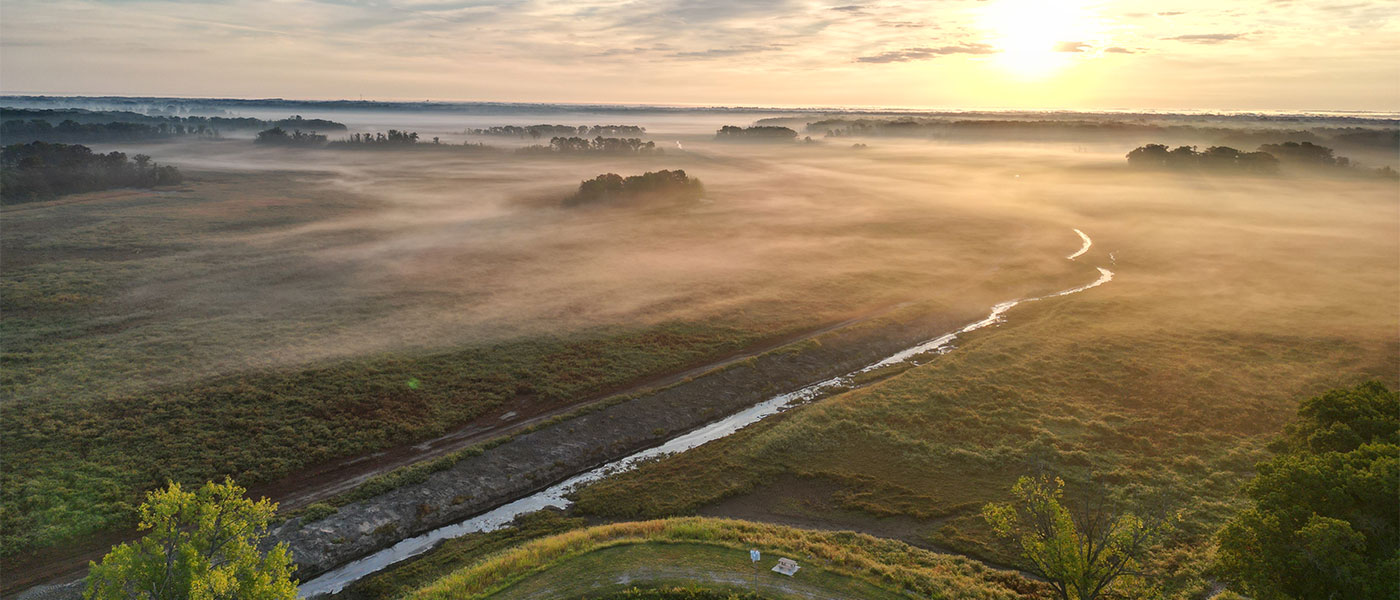
Sunrise over J.C. Murphey lakebed.
Why is the lake undergoing renovations?
J.C. Murphey Lake is a constructed lake. A large portion of the lake is shallow, less than 3 feet in depth, and is a wetland-type habitat. Due to this wetland component, J.C. Murphey Lake will always require renovations to mimic the wet/dry cycles found in nature that provide optimum habitat for fish and wildlife species. Past renovations traditionally occurred about every 12 years. The last renovation was 19 years ago in 2003. That drawdown benefited roughly 20 species of greatest conservation need in Indiana along with a host of other species, including game species.
Since the last renovation, the habitat at J.C. Murphey Lake has declined. Habitat deteriorates naturally with stable water levels, but the two years of extreme weather/rainfall (2014-2015) accelerated the decline. Higher water does not allow wetland plants to grow, and many wildlife species depend on these plants for food and shelter. The spread of invasive plants and undesirable fish species, typically introduced by people and flooding, has led to degraded habitat and reduced fish productivity. Because of this, J. C. Murphey Lake is experiencing:
- Decreased waterfowl hunting opportunities, due to declining waterfowl usage
- Fewer muskrats, leading to fewer trapping opportunities and fewer muskrat mounds that other animals use for shelter or nests
- Less desirable fish and smaller fish body sizes
- Degrading habitat for secretive marsh birds or other species of greatest conservation need
What are the benefits of the renovations?
Renovations will be used to improve lake conditions, habitat, infrastructure, and attract native wildlife. These improvements include:
- Increased opportunities for waterfowl hunters, anglers, and trappers
- More wildlife viewing opportunities
- Boat ramp, fishing piers, and aeration system maintenance and improvements
- New or improved habitat for rare and endangered native wildlife
Timeline
- 2022
- Remove fish from the lake and store in the waterfowl management units
- Draw down the lake
- Remove trash and clean up the lakebed
- Treat invasive species
- Reinforce the lake with new ditches and shoreline stabilization
- Conduct habitat enhancement projects (see details below)
- 2023
- Finish reinforcement and stabilization work
- Continue invasive species control and removal of undesirable fish
- Repair infrastructure, including boat ramps, piers, and dam controls
- Finalize habitat enhancement projects
- Begin to add water back into the lake (est. September 2023)
- Stock fish from the hatchery system
- Add fish back into the lake (est. October/November 2023)
- Open the lake for some public use, including limited waterfowl hunting
- The following fingerlings totals have been released into the lake: 311,072 Redear Sunfish, 24,909 Largemouth Bass, and 329,073 Bluegill.
- 2024
- The lake will not be returned to full water level in 2024 in order to promote vegetation growth. Full water level will return in 2025.
- Angling will be open in spring 2024.
- More fish stocking from state hatcheries
- Install floating docks and piers (est. Summer 2024)
- Open the lake to boat fishing and other recreational activities
- Monitor fish, wildlife, and habitat response to the renovation
- Continue targeted treatments of invasive species
- Goose hunting opportunities are now available.
- Fish will be collected from the Rookery and Salisbury Waterfowl Units beginning in mid-March. These fish will then be moved to the lake to supplement DNR's hatchery stocking program. If you are interested in assisting in the salvage efforts and would like to volunteer to assist, please contact Tom Bacula, District 1 Fisheries Biologist, tbacula@dnr.IN.gov.
Habitat Enhancement Projects
- Aeration System
An aeration system has been used in the bay near the boat launch to protect the piers while providing fish with oxygenated water during severe winters. The current system is no longer functioning properly and needs to be replaced. The new aeration system will help fish species survive extended periods of cold weather.
- Catfish Nesting boxes
Catfish nesting boxes will consist of open-end tubes and constructed wooden boxes. They will be placed into ditch banks throughout the lake. The boxes will provide nesting areas to enhance channel catfish reproduction, which will reduce requests for hatchery stocked fish.
- Erosion Control
Throughout the lake, various banks and shorelines have eroded, degrading habitat for fish and wildlife. In these areas, logs will be placed to break the wind and waves, which will protect the shore from erosion while also creating habitat for fish and wildlife.
- Fish Cribs
Fish cribs will be placed in locations that benefit shore and boat anglers in historically important fishing areas. These structures will consist of stacked log structures filled with smaller branches. The cribs will provide habitat for fish and improve opportunities for anglers.
- Stake Beds
Stake beds are a diverse composition of vertical oak stakes and black locust posts. The beds will provide spawning or ambush habitat for fish and will be easier to fish in and around compared to other structures that can snag baits. These structures will be placed close to shore, so watch for volunteer opportunities to help with installation.
- Tree Piles
Treetops, log sections, and root wads will be placed in various parts of the lake. Portions of these structures will extend beyond the water’s surface to create basking spots for turtles and perches for birds. Clusters of trees will be placed in various shapes with dense sections to provide refuge while allowing some portions to be accessible to anglers.



